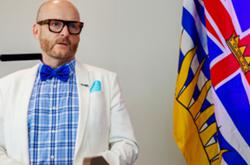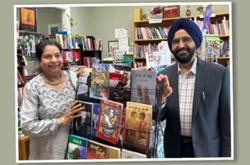
One day, fellow teachers will shake their heads at the idea that we once confiscated phones from students, refused to give them the school WIFI password, and required permission to use their own laptops in class.
After all, today's students carry with them some of the most powerful learning tools ever known. Why not teach students how to use them, rather than tell them to put them away, to leave them in their lockers or to turn them off? As teacher William Stites says on his blog, "If we want students to communicate, does it matter what tool they use to get the message out?"
BYOD or "bring your own device" policies, which started a few years back as cost-saving measures in the workplace, are now being considered in school districts worldwide -- including here in B.C. As schools struggle to meet their own technological needs, why ignore this obvious resource? Since young people have taken so readily to mobile technology, it makes sense to teach them how they can use that tool for mobile learning.
Beyond transforming the battle over mobile devices in the classroom into a learning opportunity, BYOD policies could also help realize "personalized instruction," which basically amounts to individual tutoring for each student in a classroom -- a custom-tailored suit rather than a shapeless one-size-fits-all. Lately, B.C. Education Minister George Abbott has taken an interest in personalized learning, creating an "interactive discussion guide" to get public feedback on the move towards incorporating it in B.C schools.
According to Daphne Koller in the New York Times, "Until now, it has been hard to see how to make individualized education affordable. But I argue that technology may provide a path to this goal."
Schools that block that path by adopting conservative, reactionary policies that include punishing students for use of technology, just might find themselves in the dust.
Digital-divide proofing
Schools will thrive under a BYOD policy, but only if the change is implemented as part of a well-crafted strategy.
The devices students use must meet a set of criteria, and they usually must allow students to play multimedia, browse the web, collaborate online, and create artifacts such as documents, sound files and photos. The policy will be aimed at secondary students, but middle schools may have their own policies. Districts will have to create online manuals for acceptable use; teachers, students and administration must all have a voice in their creation. Presently, the largest hurdle in most schools is discussing security issues with the IT department.
Not all teachers are on board. Many see digital devices in the classroom as a distraction. The last thing they want is a group of students texting and playing games while they should be paying attention to the lesson being delivered. Susan Lambert of the BCTF has come down hard on the idea, recently stating, "The 'bring your own device' idea and the credit for external programs are inconsistent with the founding principle of public education, universality of access, and are the next steps in the privatization of public education." Some teachers see this policy as widening the digital divide, or the gap between the haves and have-nots.
These are valid concerns. If we plan to continue with the status quo, then allowing these devices will only invite disaster. If poorly implemented, BYOD could result in a policy allowing the rich kids to play with their expensive toys, while others do without. However, in an open classroom, where students are encouraged to collaborate with one another, to seek expertise outside of the school, and to integrate their learning into their everyday lives, such an approach could thrive. Ideally, it should mean tailoring the school's technology budget towards those who really need it. Instead of three students sharing a laptop, one could be using it, while the others use their own devices. And with tablets now hitting the price of a single textbook, school-purchased devices will soon pay for themselves.
'Flip' classrooms
The "flipped classroom," which originated with the Khan Academy, is one new model that uses technology to personalize instruction. Students are instructed to listen to math lessons at home, by accessing the Khan Academy site on their computer or mobile device. This prepares them to do their homework in class, where they can get help from their teacher when they get stuck. The advantages to this model seem obvious. Students can move ahead at their own pace, only moving ahead as they master the content. The teacher then gives face-to-face feedback in real time as they practice mastering a new skill. The video content is not only engaging, but it can be paused, rewound and replayed as needed. These small chunks of video tend to be better suited to students attention spans than long lectures also. If students bring their devices to class, the teacher can show them proper use. Jim Shelton of the U.S. Education Department remarks that this new model "has tapped into the desire that everyone has to personalize the learning experience," and predicts it's "going to spread like wildfire."
Flipped classrooms are being used mostly for math, but they can be dynamite for sciences and humanities as well. Students use their mobile devices for discussion, sharing, communication, and for accessing resources. Skillful teachers, such as Wendy Drexler (cited here) can show students how to use Facebook and Twitter to build their own personal learning network. Students can connect with peers and experts through blogs, wikis and forums. Recently, a student of mine completed a novel for an English class. One option I gave him was to respond to a review of the novel that he found online. When he did so, the author of the blog not only responded to his posting, but changed her original review due to a couple of factual errors he pointed out.
In an open classroom like this one, the teacher's role changes from the expert at the front of the room to "guide at the side," who helps students make sense of the expertise they find online. This is not a demotion, but a role that requires a great deal of skill in showing students how to think critically about the topic at hand, and how to filter out information that is useful and relevant from that which isn't. These might be the most valuable skills that we can pass on to the next generation. To paraphrase Clay Shirky, there is no information overload, just filter failure.
New teaching toolbox
In an open classroom, the teacher introduces students to useful programs and applications that will help them to achieve the goals they've set for themselves. For example, a social studies teacher could show students working on a research project how to use the free app Evernote to gather notes, quotations, videos, podcasts, photos and diagrams into one place, where they can be mulled over, prioritized and organized into a project or presentation. A drama teacher might introduce students to Qikpad, so that students can collaborate on a script, writing lines back and forth in real time, while a science teacher can assign bonus marks to students who use StudyBlue to create mobile flashcards with pictures and audio that they can study while waiting for the bus. The English teacher can have students use SpiderScribe to create multimedia mindmaps that can handle documents, videos, calendars, links, images and locations. The same students can then use Storybird to collaborate upon pictured storybooks that they publish and share online.
This new, networked teacher will communicate with students, parents and colleagues using a mobile device for email, texts, instant messaging, voice mail and phone calls. Some opt to use Celly to communicate with students and parents, without either party revealing their phone numbers.
As George Abbott says in B.C.'s new Education Plan "We need to make a better link between what kids learn at school and what they experience and learn in their everyday lives." This document also discusses the need for teachers to be supported in their roles as "guides" and "coaches" so that they can put students at the "centre of a more personalized approach to learning."
It will be Abbott's call as to whether we will deal with BYOD on an ad hoc basis, or if we sit at the table with all concerned, roll up our sleeves and do it properly. That is a call that B.C.'s students are waiting for. ![]()
Read more: Education
















